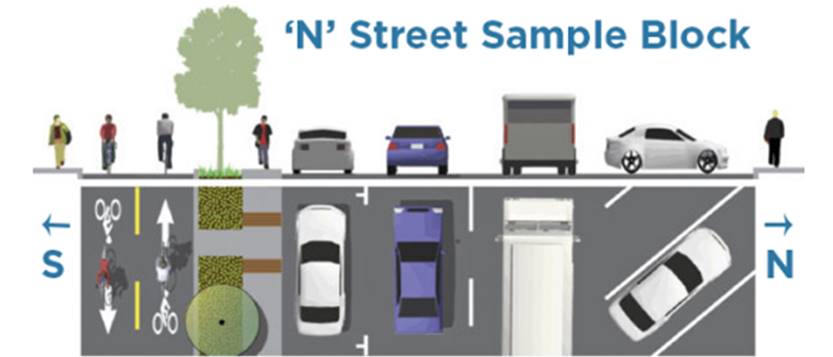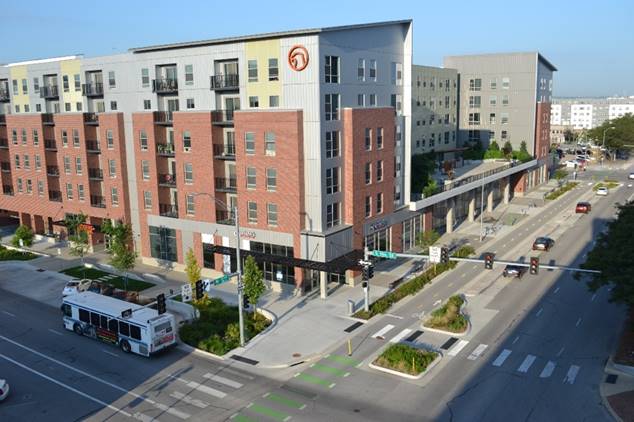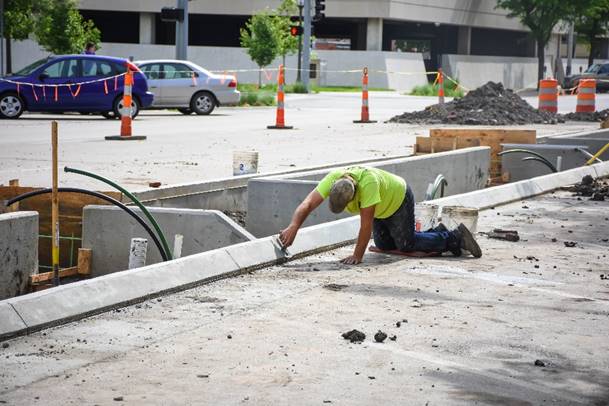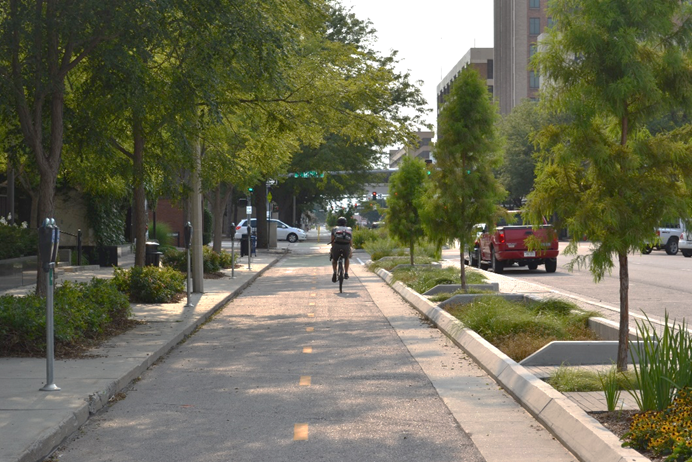The City of Lincoln, Nebraska, wanted to connect its extensive citywide bicycle trail system to—and through—its growing and increasingly vibrant downtown and wanted the connection to be safe, attractive, and inviting. To meet the final project cost of nearly $3.7 million, the city assembled funding from more than 20 sources, including a major share of funding from four TIF districts along the bikeway, as well as a small developer contribution. A business district funds a portion of ongoing maintenance.
| Project name | N Street Protected Bikeway |
|---|---|
| Location | Downtown Lincoln, Nebraska |
| Built environment | Urban |
| Economically distressed or opportunity zone | The portion of the bikeway from North 16th Street to the eastern terminus is in an Opportunity Zone. |
| Type of infrastructure | Protected bikeway with related Complete Streets Program elements, stormwater improvements, and landscaping |
| Total infrastructure cost | $3.7 million |
| Value capture instrument | Capital costs: TIF, developer contribution Maintenance: Business Improvement District |
| Summary of funding plan | Multiple TIFs contributed more than 46% of a total funding program with more than 20 sources. |
| Amount of value capture | $1.7 million for construction |
| Duration of value capture | The TIFs that contributed to this project each have a duration of 15 years and will end in 2028, 2030, 2031, and 2032. |
| Value capture innovation | This project uses multiple existing TIF districts as part of a larger funding program for an east-west bicycle facility through several critical redevelopment areas in Downtown Lincoln. |
| Notable outcomes | The project is one of several drivers of downtown residential development and overall vibrancy, and its success has prompted further active transportation infrastructure throughout downtown Lincoln. |
| Statutory and regulatory changes | No regulatory or statutory change was necessary, although the boundaries of one TIF district were expanded to accommodate this project. |
Stakeholder support is critical.
A project champion. The mayor’s commitment to the project motivated the allocation of a wide range of possible funding sources to the project, including the marshalling of last-minute TIF funds to close a significant, unexpected funding gap.
Community support for the project. Community enthusiasm for the project, rallied in part by the Great Plains Trail Network, helped demonstrate the amenity value of the proposed bikeway for private developers.
Multiple TIF districts can be used to fund infrastructure that links the TIF districts to supporting activity centers. TIFs typically fund infrastructure related to a specific private development or multiple private developments in a unified TIF district. In this case, however, it would not have been feasible to create a TIF district to encompass the entire corridor. Instead, the city was able to use funds from four new TIF districts along the bikeway that would benefit from it.
Value capture techniques can be combined to help fund multiple aspects of a project. Identifying project benefits and beneficiaries reveals potential revenue sources for both construction costs and operations and maintenance. The N Street Protected Bikeway created a one-time benefit for property owners in the affected TIF districts, a portion of which was recaptured by the TIFs to cover initial construction costs. The bikeway also created an ongoing benefit to business owners along the corridor, a portion of which was recaptured using the Downtown Business Associations to cover a share of regular maintenance.
Downtown Lincoln has experienced significant growth over the past decade, including significant higher-density residential development, which has supported new retail, dining, and entertainment offerings. Lincoln has an extensive 128-mile bicycle trail network that connects to the larger Lancaster County trail system. Downtown Lincoln, however, suffered from a last-mile problem that left it disconnected. This missing link was identified in the 2012 update to the city’s Downtown Master Plan.
In response, the city worked with a planning firm specializing in active transportation and a local engineering firm to develop the N Street Protected Bikeway plan. A range of alternatives was considered, including inexpensive designs limited to bollards and road striping. These were rejected because they did not provide the desired level of safety for cyclists and pedestrians.
The final design consists of a two-way bike path, a raised concrete median separating the bicycle facility from vehicle facilities, a parallel parking lane, two lanes for vehicular traffic (reduced from three) and an angled parking lane. The wider sections of the median are landscaped, while the narrower (3-foot-wide) sections are concrete. Intersections are fully signalized for vehicles as well as bikes (see Figure 1).

Figure 1. N Street Sample Block Layout
Source: Downtown Lincoln Association.
The bikeway connects downtown activity centers, including the University of Nebraska-Lincoln’s (UNL) City Campus, Pinnacle Bank Arena, and West Haymarket District with the regional recreation trail system. The city reports that about one-third of Lincoln’s population lives within two miles of the N Street Protected Bikeway. The estimated cost to build the project was $3.2million (see Table 1), though the final cost of the project was $3.7 million.
| Item | Cost |
|---|---|
| Construction | $2,400,000 |
| Design and administration | $525,000 |
| Maintenance endowment | $275,000 |
| Total project budget | $3,200,000 |
Source: Hicks, Nancy, “City could do N Street bikeway for much less, councilman says,” Jan. 27, 2015, Journalstar News.
The N Street Protected Bikeway was included in the 2012 Downtown Master Plan Update as a project that could be completed in the near term to catalyze downtown revitalization. Project planners cite Mayor Chris Beutler’s leadership in identifying and allocating funds to the project as critical to its completion. The Great Plains Trail Network—Lancaster County’s citizen advocacy group for recreational trails—supported the project and held a fundraiser to make a significant donation toward construction. The bikeway project attracted widespread community interest, and all but one city councilperson voted to approve it. The developers in the TIF districts contributing to the project were also supportive.
There were three main sources of opposition, which were related to the project itself rather than the value capture techniques used in the funding package. Downtown retailers initially had concerns about the loss of parking, but the city responded by converting some parallel parking on side streets to diagonal, reducing the net loss in number of parking spaces. Some businesses and residents were concerned about the loss of a vehicle travel lane in either direction, though the streets had excess capacity. The price tag gave pause to some stakeholders, including at least one city council member, who advocated for a smaller-scale project with a much lower cost and who ultimately voted against the bikeway as designed.
The project required funding from many sources, including some that were limited geographically and some that were limited to certain elements (e.g., parking, storm water management). Ultimately, the funding package included two value capture techniques: TIF and a developer contribution. Table 2 presents a summary of the construction funding sources.
| Funding Source | Amount Contributeda |
|---|---|
| Block 68 TIFb | $730,000 |
| Aspen Heights TIFb | $650,000 |
| Antelope Valley Community revitalization transfer | $500,000 |
| Great Plains Trail Network (fundraising commitment) | $340,000 |
| 21st and N St TIFb | $280,000 |
| City of Lincoln Transportation and Utilities Department, Watershed Management Division | $276,800 |
| City of Lincoln Transportation and Utilities Department, Paving and Traffic Engineering Divisions | $183,900 |
| Housing Development Grant (HoDAG) Program | $150,000 |
| Parks Department-Keno Transfer | $150,000 |
| Sale of Jayne Snyder Trail Center | $138,800 |
| City General Fund allocation (Return of unused Gold’s TIF 10th-11th St) | $67,300 |
| Engineering Services Cost Share for Removals and Restriping | $45,900 |
| City General Fund allocation (Return of unused Star Bldg. TIF) | $44,500 |
| West Haymarket Core Area TIFa | $36,000 |
| West Haymarket Joint Public Agency contribution for 8th St parking and N St node removalb | $21,500 |
| Traffic signal funding for fiber installation | $12,000 |
| Two for Trees—Parks Department | $10,000 |
| City of Lincoln Transportation and Utilities Department for Lincoln Electric System duct bank cost share | $9,200 |
| Planning Department—workshop funding | $6,100 |
| Idle Fund earned interest | $2,800 |
| City of Lincoln Transportation and Utility Department | $2,600 |
| Subtotal of TIF fundsb | $1,696,000 |
| Total N Street Protected Bikeway Funding Sources | $3,658,000 |
| TIF share of total | 46% |
Note: Bold signifies value capture sources.
a Rounded
b TIF districts
Source: FHWA Value Capture 2020 Webinar Series "Value Capture Strategies: Tax Incremental Finance Districts & Transportation Reinvestment Zones," Sep. 17, 2020.
TIFs were crucial in enabling the project, providing nearly half (46 percent) of total funding.
In Lincoln, TIFs are created to capture the increment in tax revenues resulting from a specific private development, which provide funding for infrastructure needed specifically by that development. The City of Lincoln typically draws TIF district boundaries to include only the specific development, infrastructure right-of-way, plus a small surrounding area generally limited to one block’s distance from the new development. The linear nature of the N Street Protected Bikeway presented a challenge to leveraging TIF as a source of revenue. The challenge was that the infrastructure was not associated with just one specific development project, but rather traversed several new TIF developments and linked them with activity centers, potentially improving property values in numerous locations.
Initially, the city identified two former TIFs along the bikeway that had unused fund balances that they sought to apply to the N Street Protected Bikeway project. The city’s legal counsel, however, advised that because the TIFs had closed, the funds should be returned to the treasurer. When these funds were reallocated to their respective entities (the city’s general fund and the school system), however, the mayor was able to allocate the city’s general fund share to the bikeway—for a total contribution of $111,800.
More significantly, four new TIF districts along the bikeway were identified as eligible sources of funds, though none was created expressly for the bikeway. The Block 68 TIF, which was the largest source of funds for the bikeway ($730,000), was created to support a mixed-use development on a 2-acre urban infill site near the UNL campus and the historic Haymarket District. The next-largest funding source, the Aspen Heights TIF, was created in 2016 to support a planned student apartment complex on nearby P Street. The 21st & N Street TIF was created in 2017 to support the first phase of a mixed-use development on a long-vacant site called the Telegraph District. The West Haymarket RPO TDP Phase 1 & 2 TIF was created in 2013 to support redevelopment of a former rail yard into a mixed-use entertainment district anchored by a new sports-entertainment venue, the Pinnacle Bank Arena, at the western end of the N Street Protected Bikeway.
The Aspen Heights TIF district was a last-minute addition to the funding program, filling a significant, unexpected funding gap. Establishment of a TIF representing nearly 20 percent of the bikeway’s total funding program fell through when the developer could not secure financing. At the time, the creation of the Aspen Heights TIF was nearly final. The mayor asked the developer of the Aspen Heights project to extend the boundaries of the TIF district to include a segment of the bikeway so TIF funding could be used. The developer accepted and spoke in support of doing so at the City Council meeting when the vote was taken. Ultimately, this TIF was the second-largest source of funds for the bikeway.
Table 3 summarizes the four TIFs/ contributions to the N Street Protected Bikeway, the total size (in dollars) of the TIFs, and the amount of private investment they leveraged (the value of private development enabled by TIF-funded infrastructure investments).
| Start Year | End Year | Project Name | Contribution | District Total Negotiated TIF | Private Investment |
|---|---|---|---|---|---|
| 2015 | 2030 | Block 68 Redevelopment | $730,000 | $8,111,000 | $46,500,000 |
| 2016 (2017) | 2031 | Aspen Heights | $650,000 | $7,000,000 | $45,000,000 |
| 2017 | 2032 | 21st & N TIF / Telegraph District Phase I | $280,000 | $1,617,000 | $20,607,000 |
| 2013 | 2028 | West Haymarket RPO TDP Phase 1 & 2 | $36,000 | $7,385,000 | $51,000,000 |
Source: Tax Increment Financing Report for the City of Lincoln, 2019
Two common pitfalls of TIFs are (1) market risk, which can result in a development failing to generate a sufficient tax increment to cover TIF costs, and (2) negative fiscal impacts on the general fund and other public service budgets that rely on property taxes due to diversion of tax increment during the TIF period. A common criticism of TIFs is that they are often used to subsidize development that would have occurred even without public investment rather than to catalyze development that would not otherwise occur. In such a case, a TIF acts like a tax subsidy for the private developer or landowner rather than capturing a share of publicly created value. The City of Lincoln’s TIF policies and procedures address these pitfalls.
The City of Lincoln mitigates market risk by requiring developers to agree to a not-to-protest value of the proposed development. If the assessed value remains at or falls below this value, the developer agrees to make up the difference. The need for this agreement was learned through the experience of two TIF districts, one that closed without meeting TIF obligations and another that is nearing the end of its period without yet meeting expectations.

Figure 2. Aerial View of Completed Bikeway
Photo by Joe Gilpin, Alta Planning + Design, Inc.
Negative fiscal impacts can occur when the development supported by the infrastructure investment increases demands on schools, police, fire departments, and other public services during the period when the tax increment generated by the development is still being diverted to pay for the TIF infrastructure. Pressure on these other public services, particularly on school systems, can create service deficits that reduce education quality and public safety, driving property values down. Jurisdictions may attempt to mitigate such shortfalls by increasing property tax rates jurisdiction-wide, effectively spreading the cost of the TIFs to people who do not directly benefit from the infrastructure rather than capturing value from the people who directly benefit, and driving future private investment to areas with lower property taxes.
The City of Lincoln is careful to avoid these negative impacts by reserving the use of TIFs for residential development in core areas only. These urban residential developments tend to attract fewer school children per unit, and the schools serving core areas have excess capacity to meet this demand. The school system has been uniformly supportive of the city’s use of TIFs for downtown residential growth.
TIF has not been used for any residential project in outer areas where a project would create unmet demands for public services. As a result, the city has avoided negative fiscal impacts from TIF revenue segregation.
Finally, TIFs are often criticized for acting as a subsidy to developers for projects that would occur even without public investment. It can be difficult for a public agency to determine whether or not a development would occur “but for” a public investment. Development decisions are driven by real estate market and socioeconomic factors. In a vibrant real estate market, an agency can independently evaluate these market factors and determine the impact of infrastructure availability on investment decisions. In economically distressed areas such as the core areas that the City of Lincoln is using TIF to revitalize, determining which developments need the catalyst of public investment and which would occur without it can be more difficult, such as when high development costs in popular areas drive new development to nearby distressed areas. To resolve this issue, the city requires developers to submit a written statement to the City Council attesting that a project would not be economically feasible without the TIF. Although it is possible for an unscrupulous developer to submit a dishonest statement, the City of Lincoln has successfully used TIFs to spark private investment in sites that had been in need of redevelopment for many years, a strong indicator that the but-for requirement is being legitimately satisfied.
This case study focuses on the contributions of the TIFs because they were critical to the overall funding package. But two other value capture strategies were also used: a developer contribution, which was part of the construction funding package; and business improvement districts (BID), which fund a portion of ongoing maintenance.
TIFs in Nebraska
Tax increment financing was established in Nebraska in 1980 through an amendment to the state Constitution permitting the use of TIFs to help finance redevelopment projects. In 1984, an additional amendment was passed allowing use of TIFs to help finance rehabilitation projects.
Establishment and implementation of TIFs is governed by Nebraska’s Community Development Law, Sections 18-2101–18-2144. These regulations establish a maximum TIF period of 15 years and set forth the following eligibility criteria:
The project must be located in an area declared “blighted and substandard” by the City Council.
The project must be in conformance with the city’s Comprehensive Plan and the project area’s Redevelopment Plan.
The applicant must demonstrate that the project satisfies the “but for” test—that it would not occur in the absence of TIF funding.
TIFs in the City of Lincoln
The City of Lincoln established its first TIFs in 1982 to address blight and substandard infrastructure conditions in the downtown core. Lincoln has applied the technique to more than 30 projects since that time.
City TIF regulations identify two distinct categories eligible for TIF districts: core areas and outer areas. Core area TIF projects are concentrated in the urban core and oldest areas of the city and typically support infill development and rehabilitation of obsolete infrastructure or buildings. TIFs in outer areas are used to provide new public infrastructure to unimproved areas.
In addition to state requirements, the city has established criteria for TIF projects that address the specific public policy goals established for core and outer areas. Core area criteria include benefits to low- and moderate-income populations, new housing in low-to-moderate income neighborhoods, job attraction and creation, and revitalization of properties with declining assessed values, among others. Outer area criteria—that they attract or expand living-wage employment in a primary industry or relocate businesses from an area where it is in conflict, or incompatible with existing or proposed zoning or traffic flow, to a more appropriate area—are consistent with the public policy goals established for those areas.
TIF projects must be part of a redevelopment plan approved by City Council. In creating TIFs, the city typically reserves the right to determine allocation of approximately 10 to 30 percent of TIF revenues, while the developer determines the remainder. For some TIFs, the developer pays for the infrastructure and is reimbursed through TIF revenues—as in the case of the N Street Protected Bikeway—and for others, TIF revenue is used to repay bonds issued by the city and backed by a developer’s guarantee. The determination is made on a case-by-case basis given the nature of the project and amount of funds needed.
The West Haymarket Joint Public Agency (JPA), which made a $21,500 contribution to the project, is a real estate developer created through a partnership between the City of Lincoln and the University of Nebraska. The JPA is charged with redeveloping the West Haymarket District, a former rail yard on the west side of downtown Lincoln. The contribution funded parking improvements on a portion of the N Street Protected Bikeway in the West Haymarket Redevelopment Area. Although this contribution was small relative to the overall funding package, it represents a second value capture technique: The bikeway (which necessitated the parking improvements) increases the value of the parcels the JPA is charged with redeveloping, and the contribution to the subject project captures a portion of that value.
A third value capture technique was used to partially fund maintenance of the N Street Protected Bikeway. Though much of the maintenance cost is assumed by the City Parks and Recreation Department (particularly for snow removal and tree care), much of the bikeway runs through three BIDs: the Downtown BID, the Core BID, and the Maintenance BID, which encompasses the entire downtown street and sidewalk network. These BIDs, along with the Management BID, are represented by the Downtown Lincoln Association. The Downtown Lincoln Association maintains the landscaping along the portion of the bikeway.

Figure 3. Construction of the Bikeway
Photo by Olsson Associates
Established in 1989 by downtown property and business owners, in cooperation with the Downtown Lincoln Association and the City of Lincoln, the downtown Lincoln BIDs are special-benefit assessment districts that serve the properties in the district boundaries. Approximately half of BID funding comes from membership fees while the remainder is provided by the city.
The Management BID provides coordinated economic development, parking management, communications, and advocacy programs above and beyond those provided by the city.
The Maintenance BID provides landscape maintenance, daily trash removal, sidewalk cleaning, and anything that ensures a clean, safe and inviting downtown.
Source: Downtown Lincoln Association, www.downtownlincoln.org/about/business-improvement-districts

Figure 4. Cyclist on the Completed N Street Bikeway
Photo by Joe Gilpin, Alta Planning + Design, Inc.
The N Street Protected Bikeway was completed in 2016 and is largely considered a success. Since 2016, more than $165 million in private development has occurred in downtown Lincoln, including 300 new residential units built along a two-block segment of the bikeway, and another 200 under construction at the other end of the bikeway. The last developable downtown building has been redeveloped, and developers are looking to increase building heights to accommodate demand. Although the bikeway is only one of several factors driving growth, it is a highly visible centerpiece of the area, complementing the other drivers of downtown revitalization and activity such as the Pinnacle Bank Arena and three new hotels in the West Haymarket district.
The project has also motivated further support for active transportation in downtown Lincoln, and the city is converting many downtown one-way streets to two-way streets with bike lanes. The city also raised a former floodplain and turned it into a linear park and plaza connected to the N Street Protected Bikeway.
Special thanks to Dan Marvin, Director of Urban Development for the City of Lincoln Nebraska, and Dallas McGee, AICP, Assistant Director of Urban Development for the City of Lincoln, for their time and cooperation.